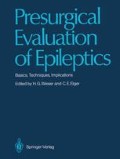Abstract
The discussion on the first two contributions centered around practical questions such as the biocompatibility of recording devices and how such information can be best achieved. The announcement that mini- and microelectrodes for ion-activity recording purposes might be available in the near future (which can be combined with some conventional electrodes used in SEEG) raised great expectations with a view toward future research in human epilepsy. Expectations were also directed towards MR spectroscopy, which may be used to study energy states by measuring31P and pH, despite poor spatial resolution at present. The UCLA experience with PET, which has been used to assess local changes in cerebral blood flow, blood volume, oxygen extraction, pH, protein synthesis, receptor binding, and oxygen and glucose metabolic rates (Mazziota and Engel 1985), demonstrated the value of this new technique both for further research into basic mechanisms of epilepsy and for the noninvasive evaluation of candidates for surgical treatment. In epilepsy most PET studies have measured glucose metabolism. Although a high correlation between the site of the interictal hypometabolic region and the site of ictal onset, recorded with scalp or depth EEG, was noted (Mazziota and Engel 1985), the use of PET in the ictal state for the purpose of localization is limited (Sperling et al. 1987). Current PET techniques require a nearby cyclotron, which is inordinate for many institutions. Although less expensive stand-alone medical cyclotrons may soon be available, SPECT is considerably less costly than PET and has therefore the potential for more wide-spread use. At the Zurich symposium SPECT was not specially represented. This was thought to be justified by the fact that only blood flow can be measured with the tracers now available. The discussion, however, revealed a strong interest in this technique. In particular, the advantages and disadvantages of the two detector types (rotating gamma camera vs that utilizing four sets of sodium iodide crystal scintillation detectors in a square arrangement that rotate about the subject’s head) and the various tracers including 123I-N-isopropyl-iodoamphetamine (IMP), 123I-hydroxyiodopropyl-dianine (HIPDM), and 133Xenon were discussed.
Access this chapter
Tax calculation will be finalised at checkout
Purchases are for personal use only
References
Mazziota JC, Engel J Jr (1985) Advanced neuro-imaging techniques in the study of human epilepsy: PET, SPECT and NMR-CT. In: Pedley TA, Meldrum BS (eds) Recent advances in epilepsy 2. Churchill Livingstone, New York, pp 65–99
Sperling MR, Sutherling WW, Nuwer MR (1987) New techniques for evaluating patients for epilepsy surgery. In: Engel J Jr (ed) Surgical treatment of the epilepsies. Raven, New York, pp 235–257
Author information
Authors and Affiliations
Editor information
Editors and Affiliations
Rights and permissions
Copyright information
© 1987 Springer-Verlag Berlin Heidelberg
About this paper
Cite this paper
Wieser, H.G., Elger, C.E. (1987). Editors’ Commentary 4. In: Wieser, H.G., Elger, C.E. (eds) Presurgical Evaluation of Epileptics. Springer, Berlin, Heidelberg. https://doi.org/10.1007/978-3-642-71103-9_24
Download citation
DOI: https://doi.org/10.1007/978-3-642-71103-9_24
Publisher Name: Springer, Berlin, Heidelberg
Print ISBN: 978-3-642-71105-3
Online ISBN: 978-3-642-71103-9
eBook Packages: Springer Book Archive

